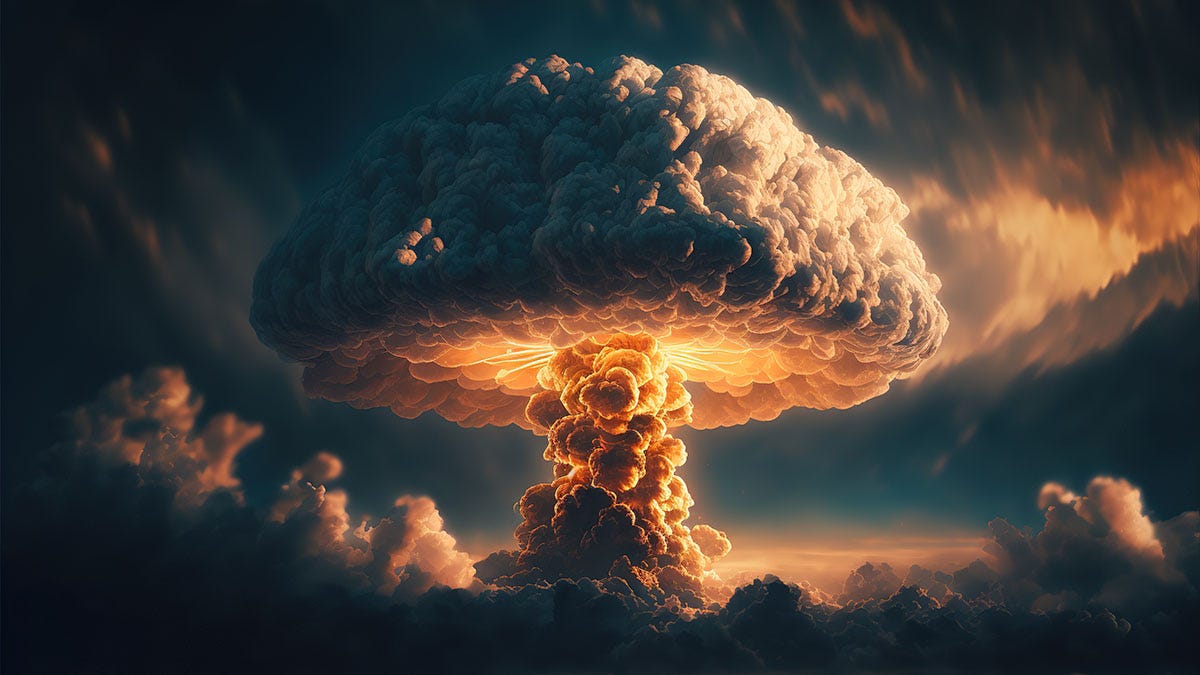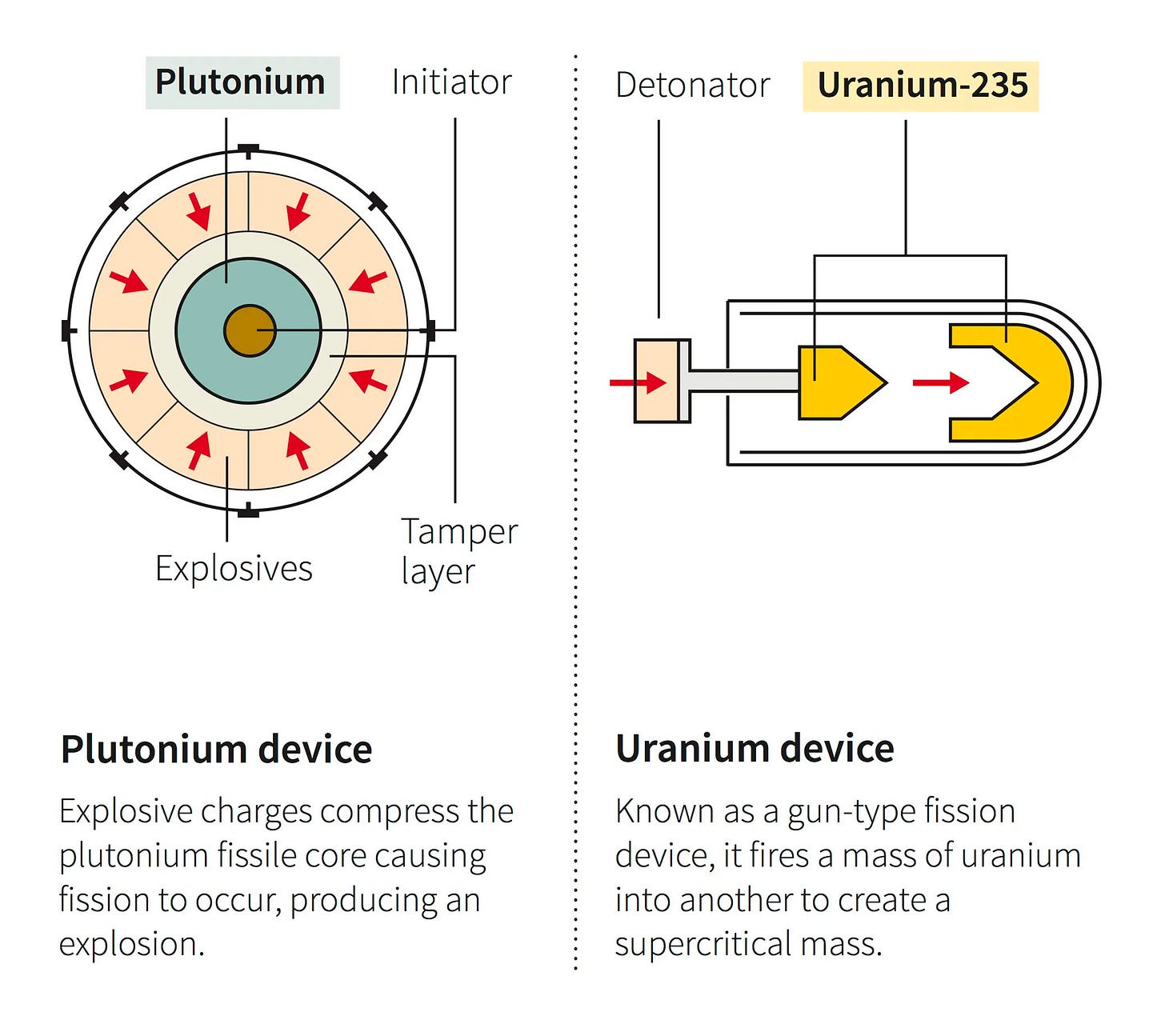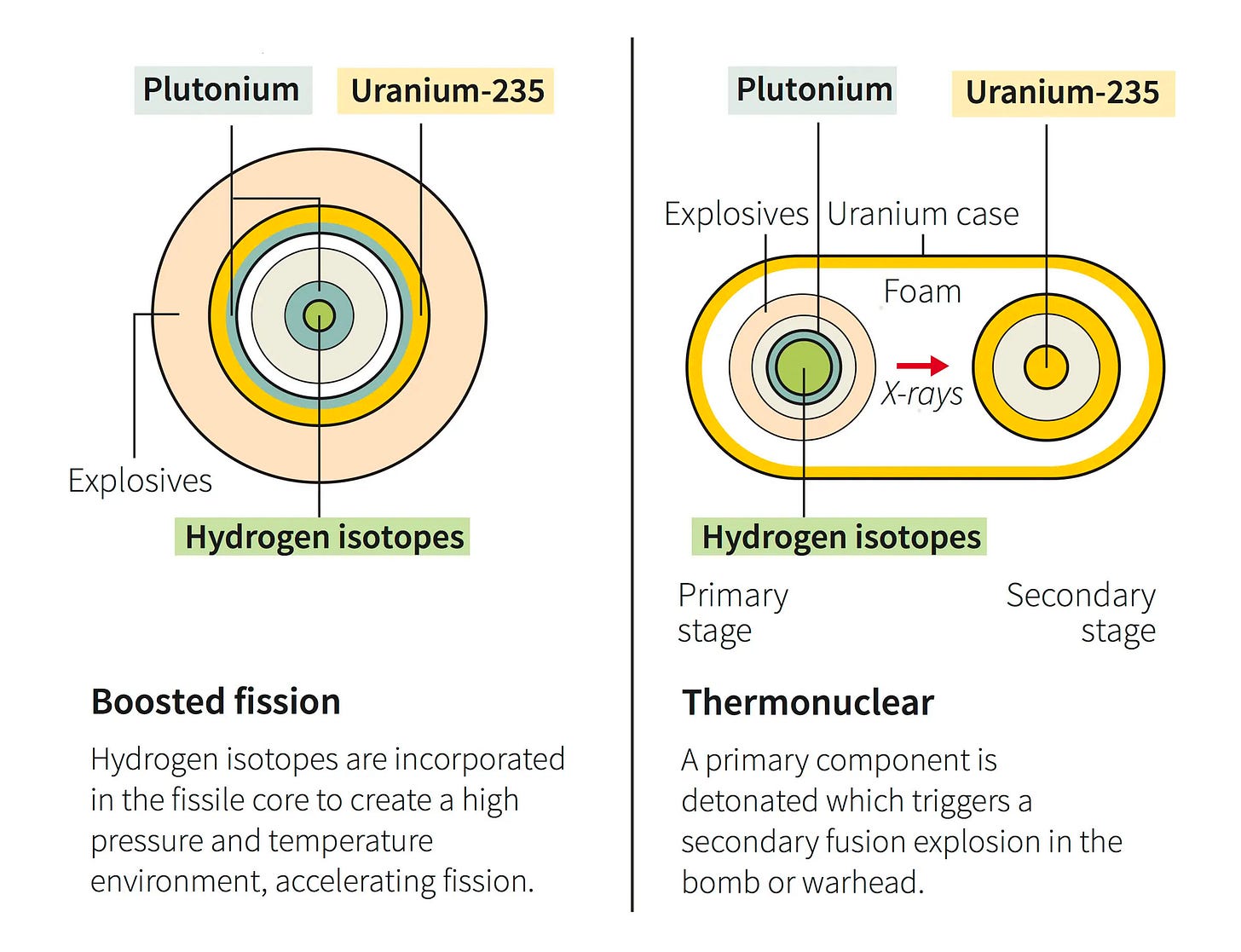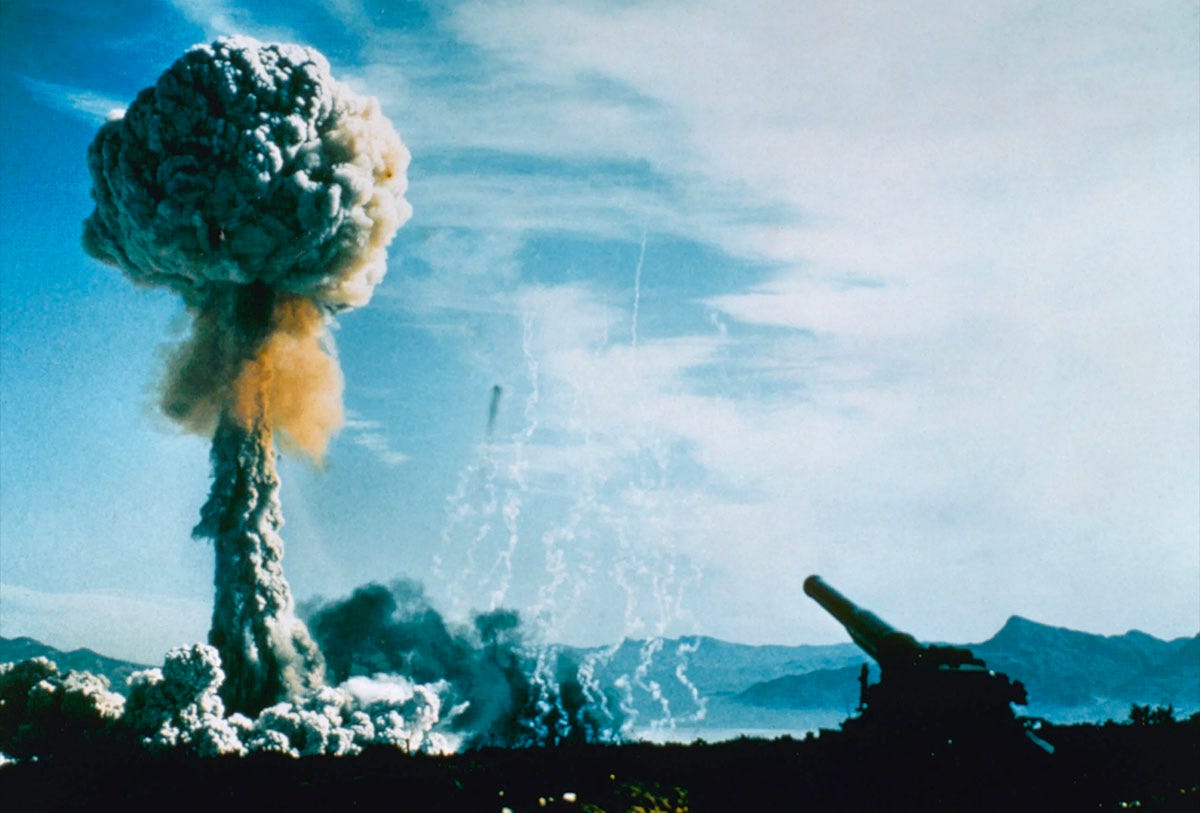how i taught my classmates to stop worrying and cautiously love the bomb
A deep dive into the technology behind the horrors unleashed on humanity after Oppenheimer's gadget successfully exploded in New Mexico.
Once upon a time, when I was still in school, I was tasked with creating a book report that focused on something pivotal to the novels we chose to read for a particular unit in English class. On a lark, I ended up with a copy of After The Bomb, a fairly decent but formulaic book about a teenager who survives a Soviet nuclear bomb detonating over Los Angeles. After finishing the story, I stood in front of my classmates and very casually explained the design of a thermonuclear warhead just like the one at the core of the story as they exchanged concerned looks. At the end of the presentation, the first question was a nervous “yeah, so, how the hell do you know all this?”
Now I was confused. Over the next 15 minutes, I found out that no, American school children do not have to learn how nuclear weapons work, how they can be detonated, or get graded on their hand drawn diagrams of fission and thermonuclear bombs. My childhood in Ukraine meant that shortly before moving to the United States, I had to take a required “civil defense” class in which we were taught both the overall designs and operation of weapons of mass destruction, and what to do to give us a chance to survive if they were used. In case you’re wondering what it was like, it involved a lot of drawing, charting, and labeling parts of horrific tools of war.
It’s been many years since that report, but with Oppenheimer opening in theaters to great fanfare, Americans’ reignited interest in nuclear weapons and “Barbeinheimer” jokes, and me learning a lot more interesting stuff over the years, I thought it may be grimly interesting to take a deep dive into the design of nuclear weapons and some of the very weird and relevant facts we rarely mention despite how ubiquitous these nightmarish weapons are today, and how used the world is to joking about the end of humanity being the result of a few hot tempers and a couple of buttons being pressed after a particularly tense phone call, which is actually not how any of that works.
The reality is that United States and Russia, and likely China, have playbooks to run in the event of a nuclear war defining how to execute an attack. Then, following a step by step guide, generals would dial up silos and provide authorizations to launch ICBM after ICBM in rapid order. Americans have silos in the Midwest, the Great Plains, and the West Coast, as well as on airbases of NATO allies. Russia has silos on bases which surround Moscow, and in the Caucasus mountains, the rumored site of its Dead Hand system known inside the country as “Perimeter.” But before we get carried away with how nuclear war would play out, let’s chart how we got here in the first place.
the sci-fi bomb that almost never was
Perhaps the most bizarre thing about what we often call “the bomb” is that it wasn’t supposed to exist. By the turn of the 20th century, we figured out how uranium can be used to create energy, despite not understanding exactly what radiation is. In 1914, sci-fi titan H.G. Wells envisioned a uranium bomb which operated not exactly unlike The Gadget built by Oppenheimer just 31 years later, in yet another example of how science fiction shaped our modern world. The one major difference between fact and fiction was Wells’ idea that a chain reaction would mean an ongoing explosion instead of just a really large release of energy in one blast.
By the 1920s, major industrial powers were looking into whether such a bomb could actually be built, eventually starting a race between the UK, U.S., and Nazi Germany, as researchers talked about the many difficulties of actually making this whole idea work since it proved rather difficult to get enough energy out of the dense, grayish, radioactive metal quickly. While politicians were mulling how they’d use these new imaginary bombs, actual scientists weren’t entirely sure it was even possible. To get energy from it for civilian purposes? Probably. To turn it into the most powerful bomb humanity has ever known? That would require a major breakthrough.
Enter the breakthrough. In 1939, just as World War II was about to start, Otto Hahn and Fritz Strassmann discovered how to make fission happen. Scientists were first impressed, then terrified. A letter co-authored by Albert Einstein warning that Nazi Germany had a real chance to build a weapon of then unthinkable power very quickly made it to FDR’s desk, triggering the Manhattan Project and enlisting Oppenheimer into supervising the creation of the American version of the bomb. Einstein, with his very lefty leanings, was sidelined as a security risk. Meanwhile, Werner Heisenberg was put in charge of the Nazi nuclear program.
Luckily for the world, Nazi Germany made some major missteps in their quest for the bomb. First of all, they scared away most of the scientists who could’ve helped them because those scientists had Jewish ancestry. Secondly, the program was never that much of a priority since it never quite achieved anything past basic research. Thirdly, it’s possible that Heisenberg slow walked the whole affair, either because he wasn’t sure it would even work — ultimately reacting with utter disbelief to the bombing of Hiroshima — or because he was intentionally undermining the effort. The latter is an attractive idea but sadly, we have nothing with which to prove it.
a winning design quickly emerges
Why were scientists so skeptical the bomb would even work? Well, despite what you see in cartoons and political jokes, nuclear weapons don’t easily explode. They’re not just fragile, highly sensitive packages of death and destruction, ready to go off after someone sneezes too hard. They have to be very carefully goaded into releasing as much of their energy as possible, and that means extreme precision is necessary for the core, tamper, and, especially, the high explosives encircling the whole thing. (The designs for those highly directional explosive “lenses” and the firing set that triggers them in a perfect sequence are some of the most closely guarded secrets on Earth.)
Nukes originally started with two very different designs. The Gadget and the Fat Man, the first and third nuclear devices, had spheres of shaped charges which compressed a solid enriched plutonium core encased by a thick enriched uranium jacket acting as a tamper to keep the energy of the implosion contained just a few milliseconds longer. Inside the core’s pit was a polonium-beryllium initiator which exploded with neutrons when compressed by the shock of the high explosives going off in perfect symmetry around it. This was the design that was tested at the Trinity Site in New Mexico and powered the bomb that destroyed Nagasaki.
The reason why you see the word “enriched” twice is because to work properly, the radioactive metals need to be of a certain purity, minimally above 93%, and ideally around 99% as perfect purity here probably isn’t even possible according to the basics of quantum physics. To enrich uranium, you turn it into a gas and spin it, letting the impurities deposit themselves in layers in the centrifuge across repeated cycles. Plutonium is a byproduct of uranium and its extraction and enrichment involves a very complicated dance of being submerged in various acids. Both processes cannot, and should not be tried at home, even under the supervision of a professional.
The second design, which used an internal “gun” to trigger the fission with a kinetic shock to the high explosive shell, was tried in the Little Boy bomb which dropped on Hiroshima and accomplished its mission, but rejected as too impractical because the gun was thought to be too slow and complex to be reliable as the goal after the war was to begin testing more reliable, predictable, and easy to produce prototypes. The next few years would see tweaks to increase yield and fine tune the mechanisms to make the bombs more durable and reliable. And to the horror of many involved in the Manhattan Project, an idea to make a bomb a thousand times more powerful still.
“i see your nuke, and raise you a thousandfold”
What drove the first nuclear weapons was a process called fission. If you were shrunk to the size of a uranium atom, you’d see clouds of charge created by its electrons and a nucleus so small, you’d need a magnifying glass to see it. (Yes, atoms are over 99% empty space.) That tiny nucleus would act as if it was being constantly zapped with a taser because it’s so heavy, the nuclear forces holding it together struggle with their task. This means that at random intervals, it shoots out a proton and two neutrons, or barfs out an energetic photon, both of which slam into other atoms like wrecking balls.
This is what we call radiation, specifically alpha and gamma decay. With uranium, we can use that instability by bombarding it with neutrons and then splitting the atom into new, smaller atoms and releasing more neutrons that hit more atoms and so on, and so forth until the neutrons run out of things to hit after a very, very long time. This is a chain reaction in fission. As atoms split, the energy that once held them together will be released as heat, radiation, and X-rays. This is what powers both nuclear reactors and bombs, but it does have an upper limit because the chain reaction will eventually create stable elements which neutrons can’t split apart with a net gain in energy.
Fusion, on the other hand, has much higher constraints. Elements from hydrogen to silicon can be fused into much heavier atoms, a part of their mass turns into as much as four times the energy of fission in the process. Nuclear scientists rather quickly realized that if you could make a fusion bomb, you wouldn’t have an upper limit until you tried to emulate a supernova. And this new fusion weapon, “the Super” could be a thousand times more powerful. There was just one problem. How do you overcome the repulsion between atoms without using tremendous gravity, like stars do?
One of the scientists most obsessed with figuring this out was Edward Teller, who had plunged into this idea for years, delegating his actual work to Soviet spy Klaus Fuchs, inadvertently helping to create the first Soviet warhead which detonated in 1949. This quieted the vociferous opposition to building this weapon at Los Alamos, and fulfilled Teller’s prognosis that it was only a matter of time before the USSR went nuclear too and the Super would become a necessity. Yet none of his designs worked, nor did any of the suggested approaches as all the fusion fuel simply vaporized. There was a faint hope that unlike fission, this bomb would actually remain in the realm of sci-fi.
how to create a sun for ten milliseconds
But you already know what happened. It turned out that this horrible weapon was also possible thanks to Enrico Fermi, of the Fermi Paradox fame, and Stanislaw Ulam. Even before the first bomb was built, Fermi posited that a fission reaction could ignite fuel for fusion. But just surrounding a fission bomb core with deuterium and tritium proved futile. There just wasn’t enough energy for ignition in these early designs. Then, Ulam offered an idea. Detonate the weapon in stages. Let the heat and X-rays from fission superheat a medium inside an even larger uranium tamper, originally a cylinder with a mix of hydrogen isotopes that could fuse into helium-4.
Despite a furious Teller insisting that he was basically testing the same idea as Ulam, so he deserved the full credit, the standard design of typical thermonuclear warheads today, like the American W88, is known as the Teller-Ulam design, and it works like so. Take the typical plutonium core fission device we covered above, wrap it in what looks like a metal peanut and foam, and put in another uranium container with deuterium — an isotope of hydrogen distilled from water — and lithium-6 which will make tritium as soon as a stream of neutrons from the tamper being bombarded with the heat and X-rays of the fission blast hit it. The second stage now implodes.
Within ten milliseconds of the first stage going off, the deuterium and newly created tritium have combined to make helium. The energy released is measured in hundreds of kilotons of TNT on the low end, and tens of megatons on the high end. But even here, the high end is relatively arbitrary. American engineers decided to stop at a 20 megaton warhead. Soviet nuclear designer Andrei Sakharov, who had a similar idea, using mirrors to focus the X-rays from fission rather than a special tamper, limited the infamous Tsar Bomb to 50 megatons after originally planning for a 100 megaton yield but dialing back by adding a lead tamper to limit the horrific fallout.
The record for the most powerful design goes to the Sundial proposed by Teller, who was still in search of an ever bigger bang. Like Spinal Tap’s amps, which maxed out at 11, Sundial was a 10 gigaton warhead. It turned out that you could just keep on adding stages to the existing thermonuclear bomb designs to get bigger and bigger yields, with 60 megatons being seriously considered by the USAF in the 1960s, and gigaton warheads on the drawing boards until the experts decided that there had to be some point where a line had to be drawn before one device had enough power to trigger a new radioactive ice age.
how to make terrifying weapons even worse
At this point, you might be thinking that the weapons we have are bad enough and it’s just lucky that we managed to put multi-gigaton blueprints in cold storage for now. It would be difficult to make these already terrifying things even worse, right? As heavily implied by the title of this section, you would be wrong. Over the decades, engineers have figured out some ways to make nuclear warfare an even scarier and more brutal proposition by manipulating how warheads can be delivered, boosting their fallout, or lowering the barrier between conventional and nuclear, making escalations more and more likely. Here’s a quick tour through the parade of horrors.
Miniaturize nukes: The aforementioned W88 warhead is shaped like a weird, oblong peanut not just for fun but because this shape allows to miniaturize the bomb. It has a 475 kiloton yield, which is on the lower side of a thermonuclear weapon, but that lets us put multiple warheads on a single ballistic missile, firing what are known as MIRVs, or multiple independent reentry vehicles, frustrating intercept attempts and spreading the damage over a wider area.
Irradiate, don’t eliminate: An insidious idea during the Cold War was to actively use radiation as a weapon by not encasing the stages of a thermonuclear weapon in thick tampers, but letting the produced neutrons fly free, if not outright boost them. You’d end up with a lower yield as the explosion doesn’t churn, creating less fissile material and keeping the fusion lit for a shorter amount of time. At the same time, however, the stream of neutrons bathes your targets in radiation, penetrates shielding, and creates mass casualties. Just in case you’re wondering, yes, a warhead like this was built: the W70 Mod 3. It was in service from 1981 to 1996.
For a smaller, cleaner nuke: Some devices took the opposite tack. The bizarre Davy Crockett system looked like something out of a cartoon, able to launch a tiny nuclear warhead from an oversized RPG launcher. The idea was to surprise tanks and dug in troop formations with a little round that would go nuclear, but it might have backfired spectacularly if it was ever used in combat. If you cross the line from conventional to nuclear, you’d most likely get a full blown ballistic missile with a proper thermonuclear warhead in retaliation. As diplomats and generals realized this unnerving possibility, the system and other experiments like it were quickly and quietly shelved.
Just add salt: Normally, some of the worst of a nuke’s fallout dissipates after several months. You could then clean up the topsoil to lessen long term effects and restart agriculture. But say that you wanted to blight an enemy’s territory for decades with a noxious mix of toxic and radioactive metals and salts? Take a primary of your typical thermonuclear warhead and encase it in cobalt. The resulting set of reactions would litter the area with some downright awful stuff, keeping you in the fallout shelter for a lot longer than you’d otherwise expect to be there.
Make it dirty: Since fusion produces light, stable elements, fusion weapons are clean and emit very little in terms of radiation. Fission breaks apart large, unstable elements, so it’s dirty by definition. This means that as you add stages to thermonuclear bombs, you could just let the heat and radiation of the previous stages ignite your next one, put in lead tampering to lessen fallout by absorbing alpha and beta decay at the cost of yield, or add more uranium-235 tampers to help ignite each stage while making the bomb “dirtier” and boost fallout.
Detonate it in space: One of the other nasty side effects of nuclear blasts is EMPs, pulses of electromagnetic radiation which knock out any devices that aren’t properly shielded. Project Starfish Prime was a test to use this power as a method of missile defense. The idea was that instead of trying to intercept many individual warheads or MIRVs, you detonate a bomb to create a field of plasma that would fry the electronics of incoming missiles. The test created massive auroras, fried satellites, irradiated our orbit further for years, and, oh yeah, damaged electronics within a 900 mile radius. It was then decided that maybe, weaponizing space with nukes would be sub-optimal.
why neither diamonds or nukes are forever
And there’s one more important thing to know about nukes. Not only do they need to be carefully goaded into detonating, they also have an expiration date. As we noted in great detail, their core fuel is radioactive. That radiation will keep going regardless of whether the bomb is used or not, and eventually, enough of the plutonium core would break down into enough stable metals and byproducts to render it almost inert. Just try to set off an old nuke and the result will be a dirty bomb with a big, loud bang. Not exactly a great outcome for all involved, true, but it would technically qualify as a more of a dud than the avatar of forbidden knowledge and destruction.
This is why every few decades, you need to get all your nukes balanced and rotated, err… scanned with X-rays to make sure the plutonium core is of sufficient purity to go off when triggered, the hydrogen gas didn’t leak, and the uranium tamper is intact so the core’s reaction can be contained for a few milliseconds to guarantee a sufficient yield to ignite the secondary. This is actually the current concern about the real state of Russian nukes. After nearly four decades of neglect, corruption, and some serious embezzlement and corner-cutting, many of the fearsome weapons Putin uses to keep saber rattling against NATO may be little more than unstable firecrackers.
Still, there could be enough viable warheads in the Russian arsenal to do damage and that uncertainty is the real killer. If you have nukes, the very fact that at least a couple of them are in good working order and have enough power to level a city is a terrific deterrent to potential attackers. If you’re a country that never had them, or gave them up, you may now want to get your hands on at least a few hundred to make even the biggest superpower think twice about invading your territory. After decades of global nonproliferation efforts, Russia’s invasion of Ukraine may have quietly reignited many smaller nations’ interest in pursuing nukes once again.
It appears that if the world of nuclear weapons has a theme song, it would be called “it’s a M.A.D. world after all,” and generations to come will need to learn its verses, as well as how the radioactive nightmares behind it actually work. Good thing they have a head start thanks to countless primers like this across the web. And as they learn about the inner workings of these fascinating but horrible weapons, they may be just as interested to learn that many of those who worked on creating them would go on to oppose their further development and use, infuriating countless politicians. But it’s easy to understand them. After all, they knew exactly what their creations could do.
![[ world of weird things ]](https://substackcdn.com/image/fetch/$s_!V-uR!,w_80,h_80,c_fill,f_auto,q_auto:good,fl_progressive:steep,g_auto/https%3A%2F%2Fsubstack-post-media.s3.amazonaws.com%2Fpublic%2Fimages%2F93728edf-9a13-4b2b-9a33-3ef171b5c8d8_600x600.png)




